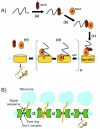A little help from my friends: quality control of presecretory proteins in bacteria
- PMID: 15516557
- PMCID: PMC524911
- DOI: 10.1128/JB.186.22.7467-7473.2004
A little help from my friends: quality control of presecretory proteins in bacteria
Figures



Similar articles
-
A novel protein transport system involved in the biogenesis of bacterial electron transfer chains.Biochim Biophys Acta. 2000 Aug 15;1459(2-3):325-30. doi: 10.1016/s0005-2728(00)00168-7. Biochim Biophys Acta. 2000. PMID: 11004447 Review.
-
Protein targeting and translocation in cyanobacterial membrane biogenesis.Biochem Soc Trans. 1996 Aug;24(3):750-3. doi: 10.1042/bst0240750. Biochem Soc Trans. 1996. PMID: 8878840 Review. No abstract available.
-
[Mechanism underlying subcellular localization of proteins in Escherichia coli].Seikagaku. 2008 Jan;80(1):36-40. Seikagaku. 2008. PMID: 18277586 Review. Japanese. No abstract available.
-
Structural determinants of SecB recognition by SecA in bacterial protein translocation.Nat Struct Biol. 2003 Nov;10(11):942-7. doi: 10.1038/nsb980. Epub 2003 Sep 28. Nat Struct Biol. 2003. PMID: 14517549
-
Structural biology: Clamour for a kiss.Nature. 2008 Oct 16;455(7215):879-80. doi: 10.1038/455879a. Nature. 2008. PMID: 18923500 No abstract available.
Cited by
-
Twin-arginine translocation of active human tissue plasminogen activator in Escherichia coli.Appl Environ Microbiol. 2005 Dec;71(12):8451-9. doi: 10.1128/AEM.71.12.8451-8459.2005. Appl Environ Microbiol. 2005. PMID: 16332834 Free PMC article.
-
Laboratory evolution of fast-folding green fluorescent protein using secretory pathway quality control.PLoS One. 2008 Jun 11;3(6):e2351. doi: 10.1371/journal.pone.0002351. PLoS One. 2008. PMID: 18545653 Free PMC article.
-
Visualizing interactions along the Escherichia coli twin-arginine translocation pathway using protein fragment complementation.PLoS One. 2010 Feb 16;5(2):e9225. doi: 10.1371/journal.pone.0009225. PLoS One. 2010. PMID: 20169075 Free PMC article.
-
Genetic selection for protein solubility enabled by the folding quality control feature of the twin-arginine translocation pathway.Protein Sci. 2006 Mar;15(3):449-58. doi: 10.1110/ps.051902606. Epub 2006 Feb 1. Protein Sci. 2006. PMID: 16452624 Free PMC article.
-
Protein export by the mycobacterial SecA2 system is determined by the preprotein mature domain.J Bacteriol. 2013 Feb;195(4):672-81. doi: 10.1128/JB.02032-12. Epub 2012 Nov 30. J Bacteriol. 2013. PMID: 23204463 Free PMC article.
References
-
- Alami, M., I. Luke, S. Deitermann, G. Eisner, H. G. Koch, J. Brunner, and M. Muller. 2003. Differential interactions between a twin-arginine signal peptide and its translocase in Escherichia coli. Mol. Cell 12:937-946. - PubMed
-
- Berks, B. C. 1996. A common export pathway for proteins binding complex redox cofactors? Mol. Microbiol. 22:393-404. - PubMed
-
- Berks, B. C., F. Sargent, and T. Palmer. 2000. The Tat protein export pathway. Mol. Microbiol. 35:260-274. - PubMed
Publication types
MeSH terms
Substances
LinkOut - more resources
Full Text Sources

